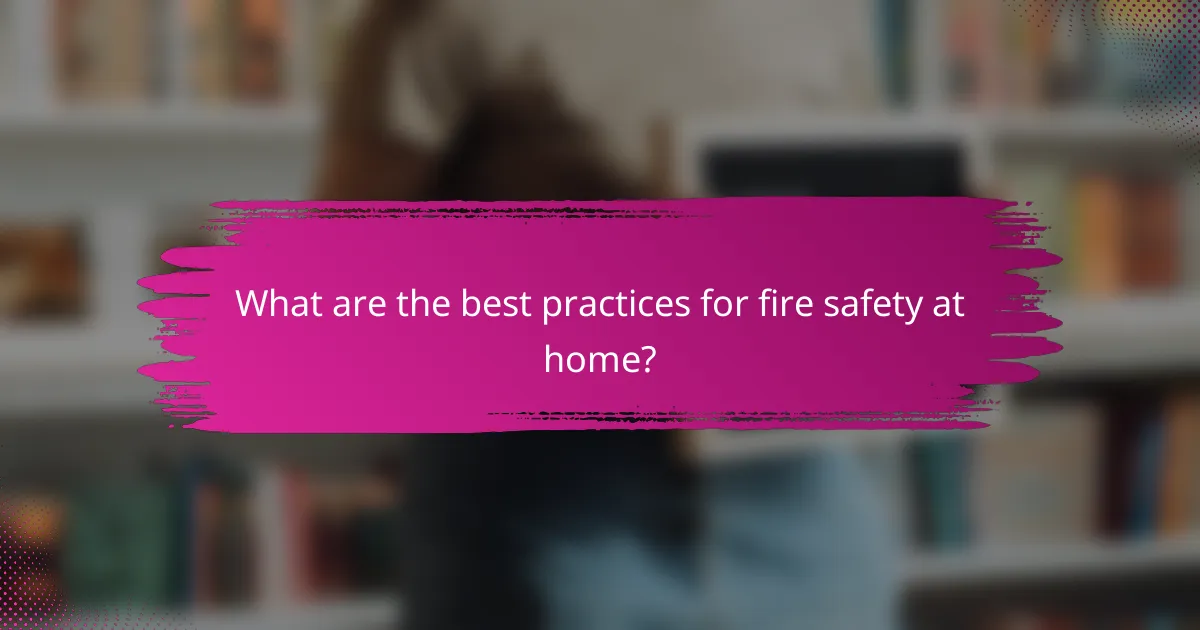Ensuring home safety is crucial for protecting your family and property from various risks, such as fire hazards, carbon monoxide exposure, and natural disasters. By understanding these threats and preparing a comprehensive emergency plan, homeowners can significantly enhance their safety and reduce panic during crises. Additionally, leveraging available resources like local initiatives and mobile applications can further bolster preparedness and mitigate potential dangers.

What are the key risks to home safety?
Key risks to home safety include fire hazards, carbon monoxide exposure, slip and fall accidents, burglary and theft, and natural disasters. Understanding these risks can help homeowners take proactive steps to mitigate potential dangers.
Fire hazards
Fire hazards in the home can stem from various sources, including faulty wiring, cooking accidents, and flammable materials. Regularly checking electrical systems and ensuring smoke detectors are functional can significantly reduce the risk of fire.
To enhance fire safety, keep flammable items away from heat sources and have a fire extinguisher accessible in the kitchen and other critical areas. Establishing an escape plan and practicing it with family members can also be lifesaving.
Carbon monoxide exposure
Carbon monoxide (CO) exposure is a serious risk, often caused by malfunctioning gas appliances, blocked chimneys, or vehicles running in enclosed spaces. This colorless, odorless gas can lead to severe health issues or even death.
To prevent CO exposure, install carbon monoxide detectors on every level of your home and test them regularly. Ensure that fuel-burning appliances are serviced annually and that vents are clear of obstructions.
Slip and fall accidents
Slip and fall accidents are common in homes and can result from wet floors, loose rugs, or cluttered walkways. These incidents can lead to serious injuries, particularly among older adults.
To minimize these risks, keep walkways clear, use non-slip mats in wet areas, and ensure adequate lighting throughout the home. Regularly inspect stairs and handrails for stability and repair any hazards promptly.
Burglary and theft
Burglary and theft pose significant risks to home safety, with homes lacking security measures being prime targets. Effective security systems can deter potential intruders and protect your belongings.
Consider installing a comprehensive security system that includes alarms, cameras, and motion-sensor lights. Additionally, securing doors and windows with quality locks and being mindful of your surroundings can enhance safety.
Natural disasters
Natural disasters such as floods, earthquakes, and hurricanes can pose severe risks to homes, depending on the geographical location. Preparing for these events is crucial for minimizing damage and ensuring safety.
Homeowners should familiarize themselves with local disaster risks and create an emergency plan that includes evacuation routes and emergency kits. Reinforcing structures and purchasing appropriate insurance can also provide added protection against natural disasters.

How can I prepare for home emergencies?
Preparing for home emergencies involves creating a comprehensive plan that addresses potential risks and outlines steps to take during various situations. This preparation can significantly reduce panic and enhance safety when emergencies arise.
Develop an emergency plan
An emergency plan should detail specific actions for various scenarios such as fires, floods, or medical emergencies. Identify escape routes, designate a meeting point outside your home, and ensure all family members are familiar with these procedures.
Regularly review and practice the plan to ensure everyone knows their roles. Consider including emergency contact numbers and local resources, such as nearby hospitals or shelters, in your plan for quick access during a crisis.
Create a home inventory
A home inventory is a detailed list of your possessions, including descriptions, values, and photographs. This inventory is crucial for insurance claims after a disaster and helps you keep track of your belongings.
To create an effective inventory, categorize items by room and include receipts or appraisals for high-value items. Store this information in a secure location, such as a cloud service, to ensure it remains accessible even if your home is damaged.
Install smoke detectors
Smoke detectors are essential for early fire detection and can significantly reduce the risk of injury or loss. Install smoke detectors in every bedroom, hallway, and on each level of your home, following local regulations regarding placement.
Test the detectors monthly and replace batteries at least once a year. Consider using interconnected smoke detectors that alert all units in the home when one is triggered, providing an added layer of safety.
Establish a communication strategy
A communication strategy ensures that all family members can stay connected during an emergency. Designate a primary and secondary contact person outside the home who can relay information if family members are separated.
Use group messaging apps or social media to share updates quickly. Ensure that everyone knows how to reach each other and has access to a charged phone or alternative communication methods, especially in areas prone to power outages.

What resources are available for home safety?
Various resources can enhance home safety, including local fire department initiatives, mobile applications, community workshops, and insurance offerings. Utilizing these resources can significantly reduce risks and improve preparedness in case of emergencies.
Local fire department programs
Many local fire departments offer programs aimed at educating residents about fire safety and prevention. These programs often include free home safety inspections, smoke alarm installations, and educational workshops on fire escape plans.
Contact your local fire department to inquire about specific services they provide. Participating in these programs can help identify potential hazards in your home and ensure you have the necessary equipment to respond to emergencies.
Home safety apps
Home safety apps can assist in managing various safety aspects of your residence. These applications often provide checklists for safety inspections, reminders for maintenance tasks, and emergency contact information.
Some popular home safety apps include “My Safety” and “Home Safety Checklist.” They can help you stay organized and proactive in maintaining a safe living environment.
Community safety workshops
Community safety workshops are often organized by local organizations or government agencies to educate residents on safety practices. These workshops may cover topics such as disaster preparedness, first aid, and crime prevention strategies.
Check local community centers or libraries for upcoming workshops. Engaging in these sessions can empower you with knowledge and skills to protect yourself and your family effectively.
Insurance resources
Insurance companies frequently provide resources to help homeowners understand their coverage and improve safety measures. Many insurers offer discounts for homes equipped with safety features like security systems or fire alarms.
Review your policy or consult with your insurance agent to explore available resources and potential savings. Ensuring you have adequate coverage can provide peace of mind in the event of an incident.

What are the best practices for fire safety at home?
Best practices for fire safety at home include implementing preventive measures, ensuring proper equipment is in place, and regularly practicing emergency procedures. These actions can significantly reduce the risk of fire and enhance preparedness in case of an emergency.
Regularly check smoke alarms
Regularly checking smoke alarms is crucial for effective fire safety. Test alarms monthly to ensure they function properly, and replace batteries at least once a year. Smoke alarms should be replaced every 10 years to maintain optimal performance.
Consider installing interconnected smoke alarms, which will alert you to smoke in any part of the home. This can provide an early warning, especially in larger residences.
Keep fire extinguishers accessible
Having fire extinguishers readily accessible can be vital in controlling small fires before they escalate. Place extinguishers in key areas such as the kitchen, garage, and near any heat sources. Ensure they are easily reachable and not obstructed by furniture or other items.
Choose extinguishers rated for different types of fires (Class A, B, C) based on your home’s specific risks. Regularly inspect them for pressure and expiration dates, and replace any that are outdated or damaged.
Practice fire drills
Practicing fire drills helps prepare all household members for a quick and safe evacuation during a fire. Conduct drills at least twice a year, ensuring everyone knows the escape routes and meeting points outside the home.
Involve children in these drills to teach them about fire safety and the importance of staying calm. Consider discussing what to do if they encounter smoke or flames, reinforcing the need to stay low and exit quickly.

How can I enhance security in my home?
Enhancing security in your home involves a combination of physical measures, technology, and awareness. Implementing effective strategies can significantly reduce the risk of break-ins and improve overall safety.
Install security cameras
Installing security cameras is a proactive way to enhance home security. These devices can deter potential intruders and provide valuable evidence in case of an incident. Consider placing cameras at entry points, driveways, and common areas.
When selecting security cameras, look for features such as high-definition video, night vision, and motion detection. Wireless options can simplify installation, while cloud storage allows for easy access to footage. Ensure the cameras comply with local regulations regarding privacy and surveillance.
Regularly check and maintain your security cameras to ensure they are functioning properly. Position them to cover blind spots and avoid obstructions. A well-placed camera can significantly increase your home’s security profile.
